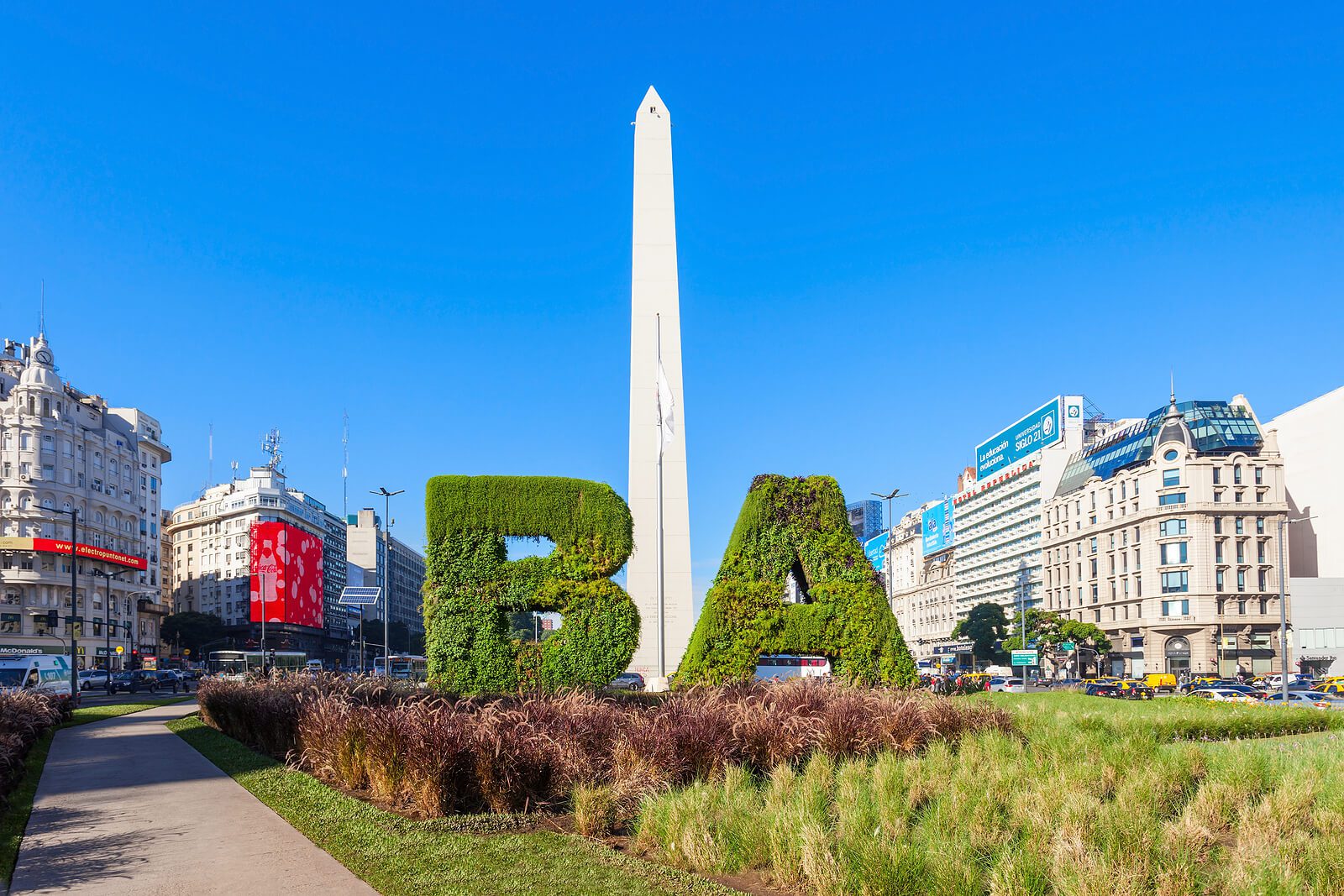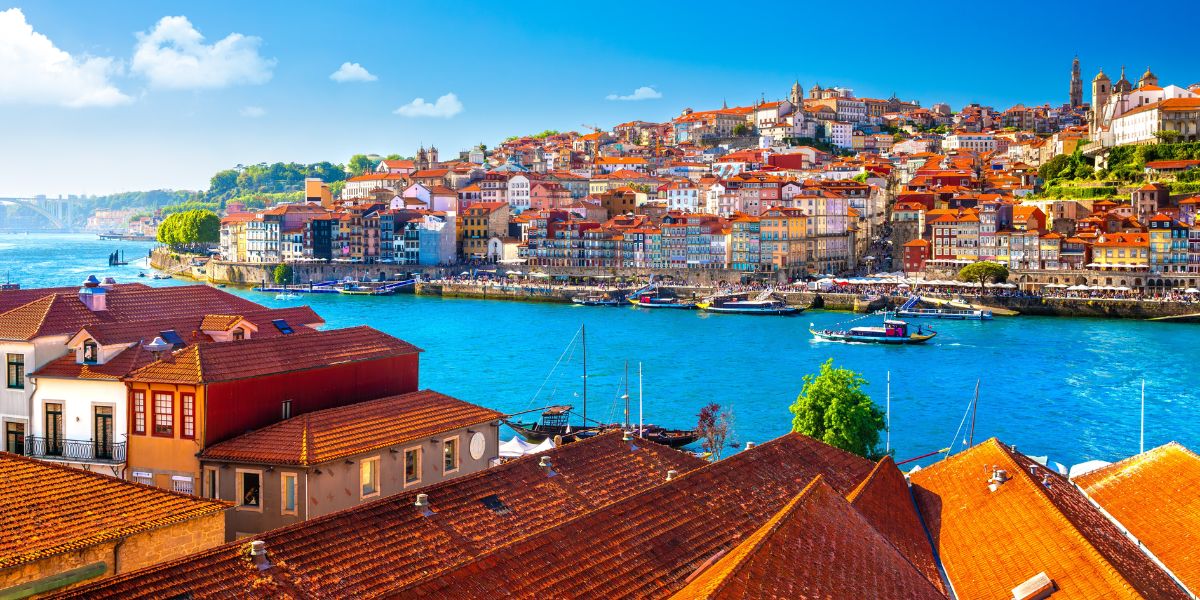“This is the story of a people which was scattered over all the world and yet remained a single family, a nation which time and again was doomed to destruction and yet, out of the ruins, rose to new life.” – Abba Kovner
There is nothing more basic than the desire to know one’s past. Since the 17th century, Jews from all four corners of the earth arrived in America in search of freedom to practice their faith in peace and as a way to persecution that had chased them for thousands of years, Yet, generations later we still crave to see where our ancestors lived and walk in their footsteps to get a glimpse into the unique culture and traditions they brought with them.
Embarking on a private Jewish heritage tour through a trusted travel agency can allow you to discover the best of Europe’s Jewish cultural sites and immerse yourself in its history with the help of expert local guides and flexible itineraries catered to your needs and preferences. Whether you’re a senior taking advantage of the best years of your life or a family looking for an educational and active heritage trip, Jewish luxury travel will allow you to pick your pace and tailor your Jewish heritage journey to create a meaningful and immersive experience that will last you a lifetime.
Read all about our top picks for the best Jewish cultural sites in the world, with personalized tips and insights into making the most of your next Jewish heritage trip.
The 10 Top Jewish Heritage Sites in the World
For thousands of years diaspora, Jewish communities across the globe managed to preserve their customs and traditions while incorporating cultural elements from the countries they resided in, whether that be in the form of architecture, literature, art, or cuisine. Today, you can find Jewish heritage in nearly every corner of the earth, from centuries-old synagogues, and World War II memorials, to Jewish quarters where communities flourished, and sometimes still do.
While there are thousands of worthwhile Jewish sites to visit around the world, we’ve narrowed it down to just ten of the top Jewish historical destinations that we think are worthy of your Jewish heritage bucket list.
1. Dubrovnik Synagogue – Dubrovnik, Croatia
As early as the 15th century, Dubrovnik was home to a vibrant and diverse Jewish community that was heavily influenced by the arrival of Jews from Spain and Portugal who found refuge in the medieval city during the Inquisition.
Today, you can still trace the footsteps of Dubrovnic’s Jewish heritage in the Old Town’s Jewish ghetto, where you will find one of Croatia‘s most significant Jewish historical destinations – the Old Synagogue. Those interested in Sephardic Jewish history should note that it is the oldest Sephardic synagogue in the world that is still in use and the second-oldest synagogue in all of Europe.
The Old Synagogue is currently used as a museum where you can step back in time through the Baroque-style architecture, and centuries-old ritual items, artifacts, and ornate textiles.
A great way to make a Jewish heritage tour in Dubrovnik more meaningful is by booking it in time for the high holidays when the Old Synagogue is still used as a place of worship.
Accommodation
If you’re looking for a luxury stay near the Old Town, look no further than Hotel Excelsior Dubrovnik. Expect luxurious interiors, stunning views, and proximity to one of the city’s historical highlights, the medieval fortress walls!
2. Auschwitz-Birkenau – Oświęcim, Poland
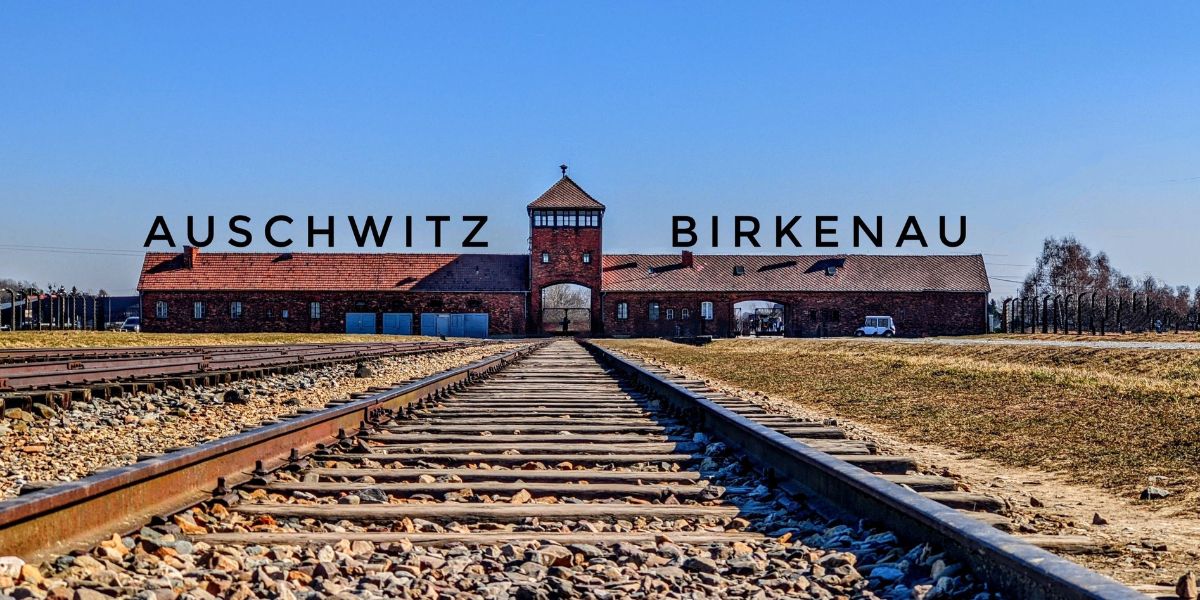
A must-visit Jewish heritage site and one of the most infamous and tragic landmarks in modern Jewish history is the Auschwitz-Birkenau extermination camp located in Oświęcim, Poland. While just one of many Nazi concentration camps across Europe, it was by far the largest, killing approximately 1 million of the 1.1 million Jewish people deported there.
While difficult for many to see, it is more important than ever to have a reminder of the past to prevent the events that led to this dark time in human history. It also serves as a way to immortalize the victims and survivors and their experiences, and for those whose families perished or survived, going to the camp is a powerful way to honor their memory.
It’s crucial to remember that Auschwitz is first and foremost a memorial site, and thus, it is important to be respectful to the victims and your fellow visitors.
A few ways you can do this is by being mindful of where you take pictures, not speaking loudly, and leaving anything you find (such as rocks) behind. It is also prohibited to eat on the grounds, so be sure to fill up before entering the site. We would also recommend that you dress comfortably and appropriately for the weather, as it is a big area requiring a lot of walking.
Book a free entry ticket to explore the Auschwitz-Birkenau Memorial on your own or reserve a ticket that includes a guided tour to ensure a meaningful and immersive experience.
3. The Jewish Quarter – Prague, Czech Republic
Home to one of Europe’s most magical Jewish historical destinations, Prague is one of the oldest and continuously lived-in Jewish communities in Europe, with mentions of Jewish life dating back to 950 CE!
Prague has become a fan favorite among Jewish families thanks to the spooky myths and folklore that surround the city, including the famous Golem – a man created from clay in the attic of the Old New Synagogue.
You can dive right into the heart of the city’s Jewish heritage by exploring the Jewish quarter, known locally as Josefov, as it has been the center of Jewish commerce and religious life for over a thousand years. While traipsing through the area, you will discover many significant Jewish sites, including:
- Synagogues – The Jewish Quarter is home to seven synagogues – The Old New Synagogue, Jerusalem Synagogue, Maisel Synagogue, Pinkas Synagogue, Spanish Synagogue, High Synagogue, and Klausen Synagogue.
- Jewish Museum – Established to preserve the community’s history and save artifacts from the city’s synagogues, it now boasts the largest collection of Judaica in the world!
- Old Jewish Cemetary – Stroll through one of the oldest Jewish burial sites in the world and look out for the unique motifs and symbols on many of the tombstones.
Dining and Accommodations
If you get peckish along the way, you may be happy to hear that there is a pretty good selection of kosher dining establishments, with a mix of cafes, and European and Middle Eastern restaurants. Keeping kosher while traveling can be difficult, so you may want to consider a kosher hotel, where dietary and religious needs are catered for.
Looking for a Jewish luxury travel experience in Prague? We highly recommend the King David Hotel– a 5-star boutique hotel in the heart of Prague that is certified kosher under the supervision of Rabbi Eliyahu Rotenberg from Jerusalem and the Rabbinat kashrut department of Prague’s Jewish community. Other luxury accommodations in the area include Angelo by Vienna House, Ambassador Zlata Husa, and the Four Seasons Hotel.
4. Anne Frank House – Amsterdam, Netherlands
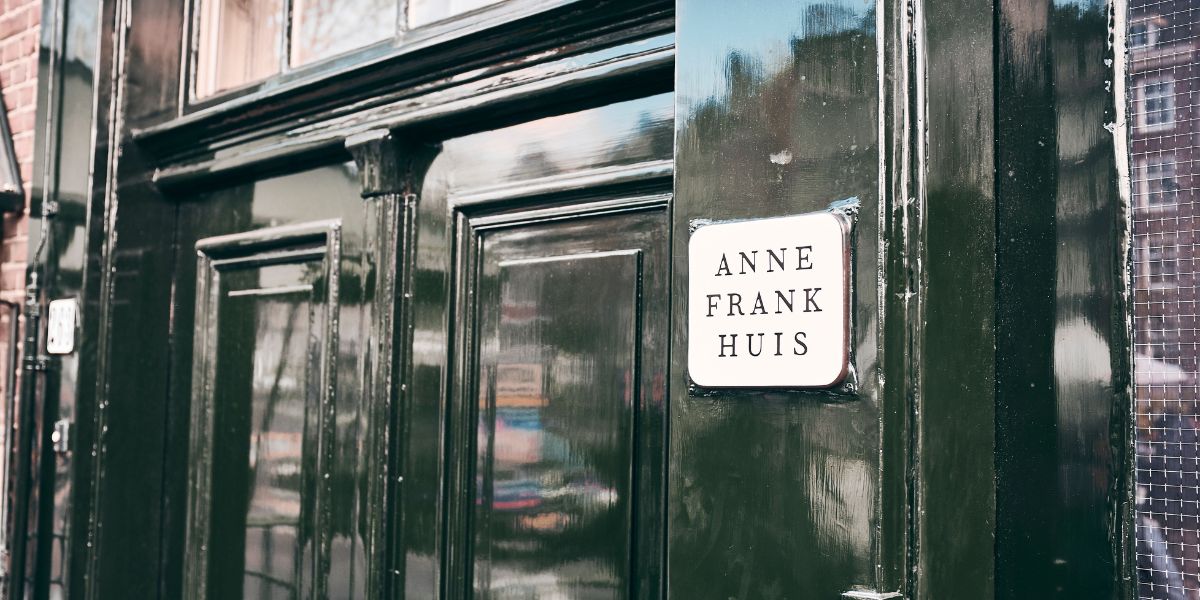
Known for its twisting canals, laid-back vibe, and charming architecture, many are unaware of Amsterdam’s Jewish community that flourished for nearly 500 years before the Holocaust.
A Jewish tour to Amsterdam is perfect for families, senior travelers, and educational tours, as it includes one of Europe’s must-visit Jewish heritage sites– the Anne Frank House. This historical gem tells the story of Anne Frank through her diary, which was published by her father Otto Frank.
The museum includes the main house and the Secret Annex, Anne Frank’s room, stories and illustrations found in her diary, personal objects of the people who hid there, and more. You will also be able to watch video interviews of Holocaust survivors who knew Anne from before the war and the concentration camp.
Through the official Anne Frank House website, you can book a ticket with an introductory program in which a guide will walk you through the museum’s history, Anne Frank’s experience during World War II, and the persecution of Jews in the Netherlands.
Amsterdam offers many attractions suited for all ages, including the Portuguese Synagogue, the Keukenhof Gardens, the Van Gogh Museum and the Rijksmuseum where you can marvel at the works of the Netherlands’s most beloved artists.
Tips for Your Trip
During your visit to Amsterdam, we highly recommend that you indulge in the local culture by attending a street market for a chance to taste local treats and produce and shop for unique handmade trinkets that you can take home as souvenirs.
It’s also important to remember that tipping culture in the Netherlands is not the norm and you are not expected to give tips to restaurant staff or service industry workers. If you had a really good experience and want to show your appreciation, we’re sure a tip would be happily accepted!
5. The Synagogue of El Tránsito – Toledo, Spain
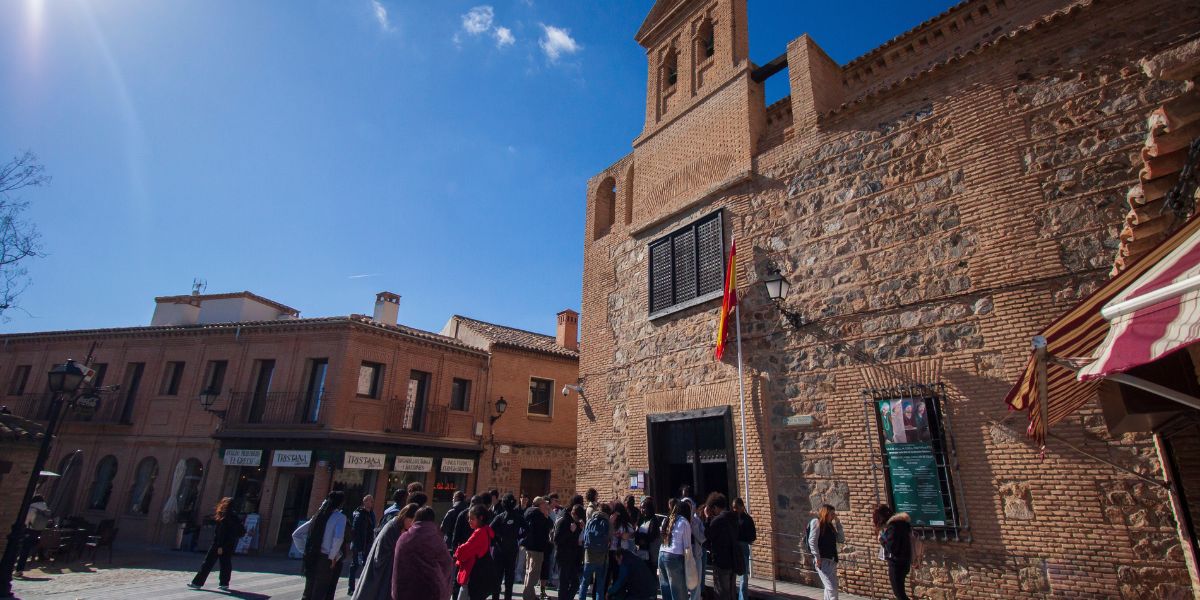
Located within Toledo’s medieval Jewish quarter, the El Tránsito Synagogue is a spectacular piece of Sephardic Jewish history dating back to 1357 that should not be missed! The synagogue was commissioned by Samuel Halevi, treasurer of King Peter of Castile, to be used as a personal house of worship and a Jewish center for learning.
With the expulsion of the Jews from Spain in 1492, the synagogue underwent many changes, which included turning into a hospital, converting to a church, and being used for military barracks during the Napoleonic War. In 1910, the synagogue became officially known as the Sephardic Museum, which is a space within the El Tránsito Synagogue dedicated to the rich and tumultuous history of Spain’s Jewish community.
While the synagogue’s exterior is built with unassuming brick and stone, inside you will find breathtaking architecture influenced by Islamic and Christian buildings, featuring elements such as Nasrid-style stucco, multi-foil arches, and a Mudéjar artesonado ceiling, alluding to Spain’s melting pot of cultures. The museum also showcases a plethora of ancient coins, marriage contracts, liturgical utensils, maps, and archaeological remains.
Once you’ve finished touring the synagogue, you can find several nearby Jewish cultural sites, including the Greek Museum, which was once Samuel HaLevi’s house, the Santa Maria la Blanca Synagogue, and the Jewish House (Casa del Judío) which is believed to have been a mikveh.
6. Jewish Museum Berlin – Germany
Take advantage of one the most comprehensive Jewish museums in the world, providing a wide range of exhibits that illustrate Jewish culture, religion, and Jewish history, with an emphasis on Jewish history in Germanic areas. Visitors can also access permanent exhibitions, such as the Shalekhet – Fallen Leaves installation by Menashe Kadishman, temporary exhibitions, regular events, and workshops for both adults and children.
You may also notice the museum’s distinct and purposeful architecture, which was created to give visitors a disorienting experience and connect them to the plight of the Jews in Germany through the centuries.
If you’re in Berlin as part of a Jewish heritage trip, the Jewish Museum Berlin is a perfect place to spend a meaningful day exploring, understanding, and reflecting on the Jewish community’s complicated history and its role in shaping German society throughout the centuries.
The Jewish Museum Berlin is open from 10 am to 6 pm every day and admission to the core exhibition is free to the public. Temporary exhibitions cost €4 to €10. Guided tours for the public, pre-booked tours for groups, workshops, and guided tours with external licensed guides are also available through the official website.
Once you’re done exploring the museum, you can hop on over to several nearby attractions, including the Berlin Gallery, Brandenburg Gate, The Holocaust Memorial, Berlin Story Bunker, and the Memorial of the Berlin Wall to name a few!
Accommodations and Dining
As one of the most popular cities in the world, there is no shortage of top-notch hotels in Berlin. That being said, there are definitely some luxury accommodations in the city that are a cut above the others. A few of our favorites include Hotel Adlon Kempinski, Hotel de Rome Berlin, and Hilton Berlin.
When it comes to dining in Berlin, you cannot go wrong with Rogacki – a Berlin institution serving up traditional German dishes and functioning as a delicatessen since 1932. If you’re out for upscale eats, try the 3-star restaurant Rutz for regional and seasonal German dishes using locally sourced high-quality ingredients.
7. Dohány Street Synagogue – Budapest, Hungary
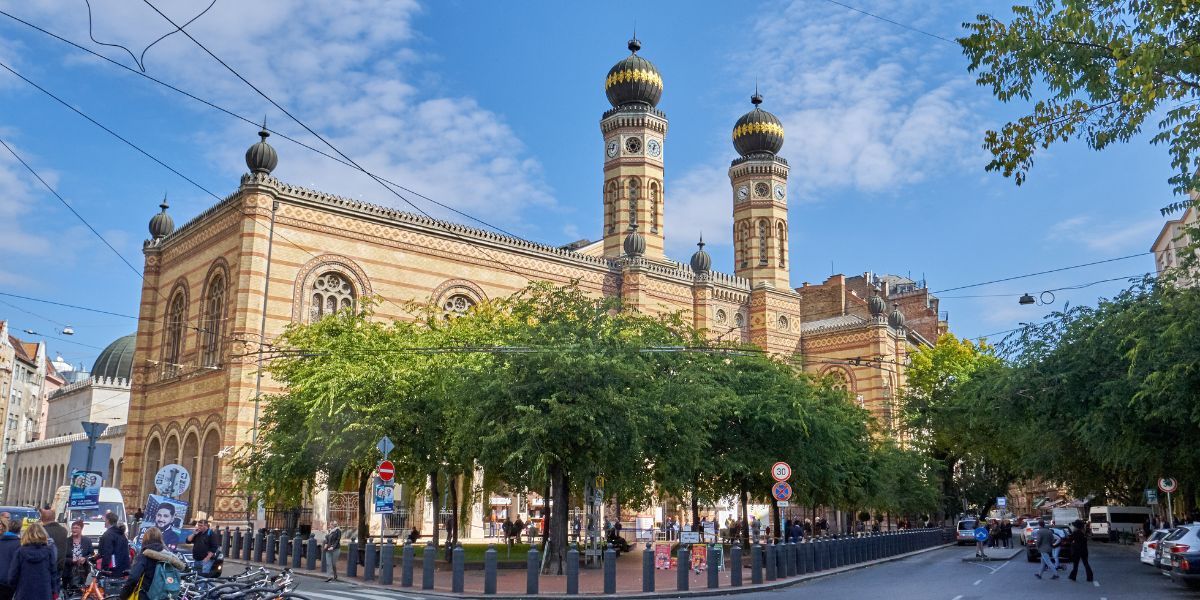
The Dohány Street Synagogue is grand in all senses of the word, from the exquisite design to its sheer size, accommodating up to 3,500 people, making it the largest synagogue in Europe!
Like many of the synagogues on our list, the stunning architecture of Dohány Street Synagogue is compromised of many cultural influences and architectural styles, creating a place of worship that is truly special to Budapest. The synagogue was built in 1854 and consecrated in 1859, with the Moorish Revival and Romantic and Byzantine influences. The architect, Ludwig Förster, was Catholic, and the Christian elements are plain to see, with a basilica-style layout, the rear-facing Torah reading table, and an organ.
The synagogue not only served as a place of worship but also as a shelter and cemetery for the thousands of Jews who perished in the ghetto between 1944 and 1945 during the Holocaust. Today, the Dohány Street Synagogue is home to some of the most significant Jewish heritage sites in Hungary:
- The Great Synagogue
- Heroes’ Temple
- The Jewish cemetery
- Raoul Wallenberg Memorial Park and Imre Varga’s “Tree of Life”
- The Jewish Museum
You can buy a ticket to the Dohány Street Synagogue which includes a free guided tour of the synagogue and access to all of the sites in the complex. If you still have some free time to explore, the ticket also happens to be valid for the Budapest Ghetto exhibitions in the Cellar and the Lapidarium.
Another way to explore Budapest’s Jewish heritage is by visiting local Jewish community members at the only JCC in Hungary, the Balint House, where you will get a better understanding of how Jewish life in Hungary continues to strengthen and flourish to this day.
Accommodations and Experiences
Ready to head over to Hungary? We recommend a stay at the Kempinski Corvinus Budapest, Four Seasons Gresham Palace, or Raddison Blu Beke Budapest for the ultimate luxury Jewish travel experience! These hotels offer a 5-star experience while being conveniently located in the heart of Budapest for easy access to the city’s top sites. Once you’re ready to get away from the city crowds, take a drive out of Budapest to visit one of Hungary’s 22 wine regions for a relaxing day surrounded by scenic views and great local wine.
Lastly, you can’t visit Budapest without winding down in one of its famous thermal baths, renowned for their therapeutic properties and beautiful design. Gellért Baths is one of our favorites because, unlike other thermal baths, private sessions can be arranged for a more exclusive experience.
8. The Ghetto Memorial – Venice, Italy
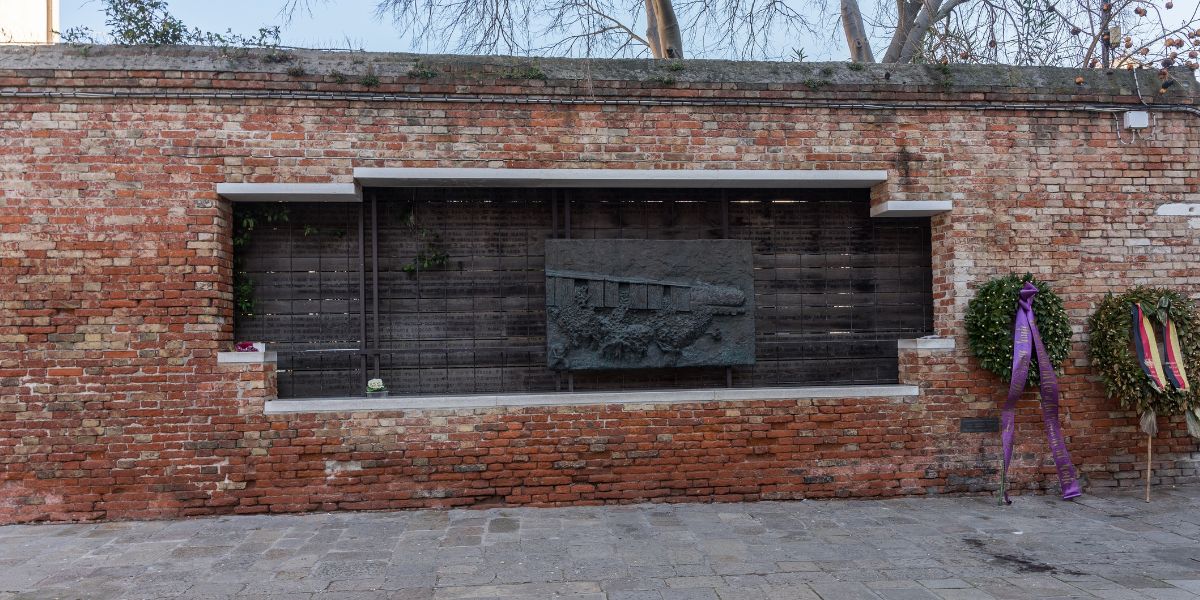
Millions of tourists flock to Venice every year to experience the beautiful city’s romantic canals, picturesque views, and rich history, which includes its centuries-old Jewish community. The Jewish Ghetto in Venice was founded in 1516 and is the oldest of its kind in all of Europe. The ghetto was home to Italian, German, Portuguese, and Levantine Sephardi Jews for centuries, with each nationality contributing to Venice’s diverse and unique Jewish identity and heritage.
Through hundreds of years of persecution and heavy restrictions, Venice’s Jewish community thrived and remains standing to this day, with a culturally active community of 450 Jewish residents.
While there are quite a few Jewish cultural sites to see in Venice, the Ghetto Memorial or the Monument to the Deported truly stands out for its tragic yet moving backstory. This art installation, located in the Ghetto Nuovo Square, commemorates the 246 Venitian Jews who were deported to Nazi concentration camps on December 5th, 1943, and August 17th, 1944. The reason why so few Jews were deported is due to the courage of Giuseppe Jona, head of the Jewish community and a physician, who made the difficult decision to kill himself rather than turn over the list of Jews who lived in the ghetto. Thanks to his act of heroism, over 1,000 Venetian Jews were saved from deportation.
Today, visitors can see how the past and current Venetian Jewish community live by wandering through the Jewish ghetto’s streets, where in addition to quaint art galleries, trinket shops, and cafes, you will pass by five Jewish synagogues representing the different ethnicities that resided in the ghetto, a Jewish cemetery dating back to the 14th century, and the Jewish Museum, which houses religious artifacts, textiles, and an exhibition on historical events of Venice’s Jewish community. Also, be sure to keep an eye out for “stumbling stones”, which are brass plaques in memory of the Venetian Jews deported to Nazi concentration camps that are located by the victims’ homes.
Venezia Ghetto offers guided tours where an expert will navigate you through the lagoon’s Jewish history and cultural sites! If you’re coming as a group and wish for a more intimate experience, you can contact them to arrange a private tour of the city.
For a more customized experience that takes into consideration activity level, the number of people, and interests, you may want to book a tour through a travel agency. Gil Travel offers private Jewish heritage tours of Italy that will give you insight into history and culture through the expert knowledge of local guides.
Accommodations and Local Dining
If you’re planning to stay the night in Venice, the Carlton On The Grand Canal is at the top of our list for its spectacular views of the Grand Canal and old-world decor and elegance. For a kosher experience, book a room at the Rimon Place – a charming boutique hotel conveniently located in the center of the Jewish ghetto.
Savour an unforgettable dining experience, by reserving a table at Ristorante Local for new Venetian cuisine featuring a 9-course menu with fresh ingredients from the lagoon, the sea, and land. The restaurant overlooks a picturesque canal, making it a perfect way to relax and enjoy a meal after a long day of touring the city.
9. Jewish Quarter – Marrakech, Morocco

Mellahs, or Jewish quarters, have been around for centuries in Morocco as a way to protect Jews under their dhimmi status. The first of these Mellahs was established with the arrival of Sephardic Jews to Morocco in great numbers from the Iberian Peninsula after the Reconquista and the expulsion of Jews from the Iberian Peninsula in 1492. The Mellah in Marrakech was created by decree of the Sultan Abdallah al-Ghalib in 1558. It was a district reserved for Jewish residents located in one of the main commercial centers of the city.
Today, the Jewish quarter in Marrakech is a feast for the senses, with the Mellah Market, or souk, filled with bright colors and pungent scents, exquisite traditional Moroccan architecture. While the Jewish community has diminished greatly in the last century, you can still get a picture of their unique customs and traditions by visiting the city’s many cultural Jewish sites, which include the exquisite Slat al-Azama synagogue, the Jewish Miara cemetery, Ben Attar gate, and the Dar El Bacha Musee des Confluences.
A great (and filling) way to explore any culture is through its cuisine. Morocco’s traditional fare includes traditional tajine stews filled with kefta meatballs, chicken flavored with lemon and olives, or lamb and sweet prunes, grilled meats and kebabs, and of course, a steaming cup of Meghrebi mint tea to finish off your meal! If you’re looking for somewhere to eat on the go, stop at the Djemaa El Fna Food Stalls for traditional eats and treats as far as the eye can see!
There are many options available for group and private tours, from city tours featuring Marrakech’s top cultural highlights, Jewish heritage tours full of insight into the community’s culture and history, to adventurous day trips to the Atlas Mountains and Green Valleys which are just south of the city.
If you’re a senior traveler looking for a more personalized travel experience, booking a private tour through a reputable travel agency could be the way to go. This allows for a more flexible schedule with activities curated to your needs and interests. A local guide will be able to expertly navigate you through Marrakech’s busy streets and give you a deeper understanding of the city’s history and the significance of its cultural site with their in-depth knowledge of the area and offer recommendations of what to do and what to avoid, as well as the best local eats!
Accommodations in Marrakech
During your stay in Marrakesh, you will have no trouble finding luxurious accommodations. If all of the options seem a bit overwhelming, we highly recommend La Mamounia Marrakech, an oasis in the middle of the city, just a 2-minute walk from the Koutoubia gardens. Established in 1923, the opulent hotel, famously visited by Winston Churchill, boasts 135 rooms and 71 suites designed with traditional Moroccan craftsmanship with modern decor and amenities.
10. Buenos Aires Jewish District, Argentina
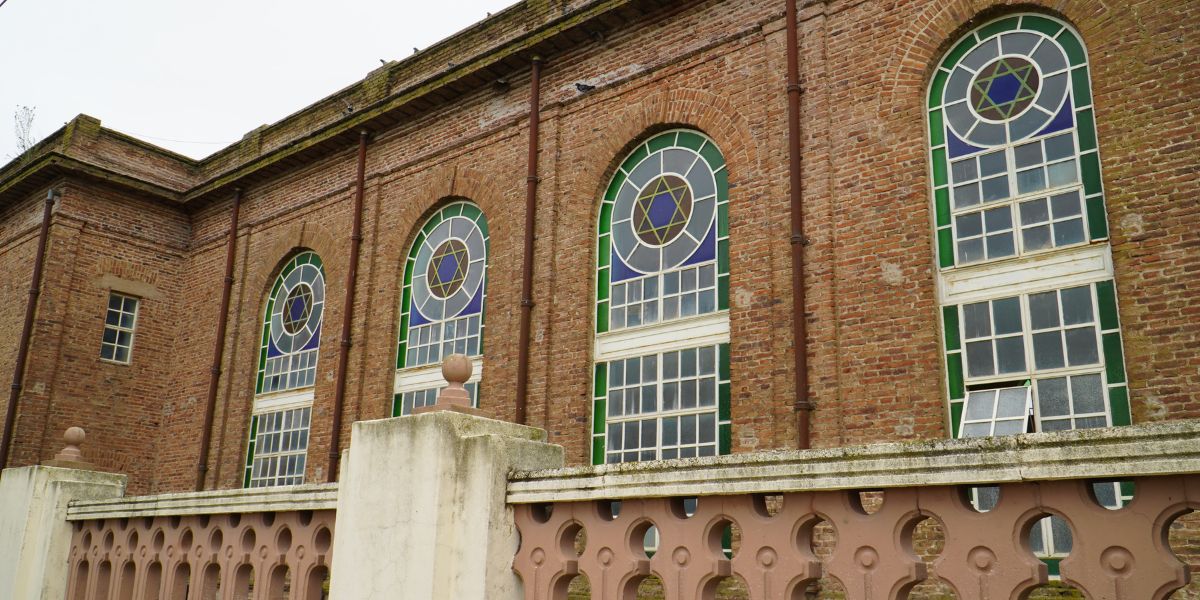
In terms of Jewish historical destinations, Bueno Aires, Argentina is not the first place that jumps to mind. However, you may be surprised to know that Buenos Aires is home to the largest Jewish community in Latin America and the seventh biggest in the world!
Like many Jewish communities in the diaspora, Argentina’s Jewish community was founded in the 16th century in the wake of the Inquisition. Later on, many Jews from Western Europe would also find themselves immigrating to Argentina to escape the social and economic pressures.
The first Jewish institution established in Buenos Aires was the Roman-Byzantine style Sinagoga de la Congregación Israelita Argentina, which was built for the ever-expanding local community in 1862. Like many synagogues in the diaspora, it also hosts a museum called the Buenos Aires Jewish Museum, which conveys the story of Jewish immigration to Argentina and the establishment of Buenos Aires’s Jewish community. Another nearby must-see is the Holocaust Museum which delves into the lives of the Jews in Europe and Argentina before and during the war. You can also get access to archives filled with powerful testimonies from Holocaust survivors who migrated to Argentina after the war.
Once you’ve finished touring the synagogue and museums, head over to Balvanera to explore the largest Jewish neighborhood in Buenos Aires filled with Jewish-owned businesses and restaurants, and the headquarters of the Asociación Mutual Israelita Argentina (AMIA), which was bombed in 1994 in Argentina’s worst-ever terrorist attack.
If you haven’t been to the Anne Frank House in Amsterdam, make time in your itinerary to visit the Centro Ana Frank Argentina. This exhibition recreates the room where Anne Frank wrote her diary and reveals details of her daily life and those living in the Secret Annex through historical documents and original photographs. The educational center was opened to the public in 2009 in honor of the 80th anniversary of Anne Frank’s birth.
Accommodation
After a long day of touring, put your feet up and relax in one of our favorite hotels, the Buenos Aires Marriot Hotel. The space offers a modern and sophisticated experience in a prime location, close to some of the city’s most iconic landmarks, such as the Obelisk, the Teatro Colón opera house, the Palace of Justice, and the famous 9 de Julio Avenue.
Start the Journey into Your Jewish Heritage
We all know that the past shapes the future, and exploring your Jewish heritage is a crucial way to ensure the continuation of the traditions, customs, and culture that Jewish communities across the globe kept alive for centuries. Each of the historical Jewish destinations we mentioned offers great insights into how our ancestors kept their faith while integrating into different cultures in the face of persecution and discrimination.
Embarking on your own journey to one of these destinations will not only deepen your connection to your Jewish heritage but also give you an appreciation for the sacrifices these Jewish communities made to practice their religion and keep their traditions alive so as to pass them on to the next generation. Walking in the footsteps of your ancestors and seeing firsthand how they lived and preserved their culture is an experience you will likely never forget.
At Gil Travel, you can discover these must-visit Jewish heritage sites in style and comfort with our Jewish luxury travel packages! We offer private tours with fully customizable itineraries that can be adjusted to your needs and preferences, local tour guides with expert knowledge of the area’s Jewish history, hidden gems, and all of the best spots in town.
We firmly believe that it’s never too late to travel the world and create memories that will last a lifetime. Contact us today to find out how we can make your dream Jewish heritage trip come true!
